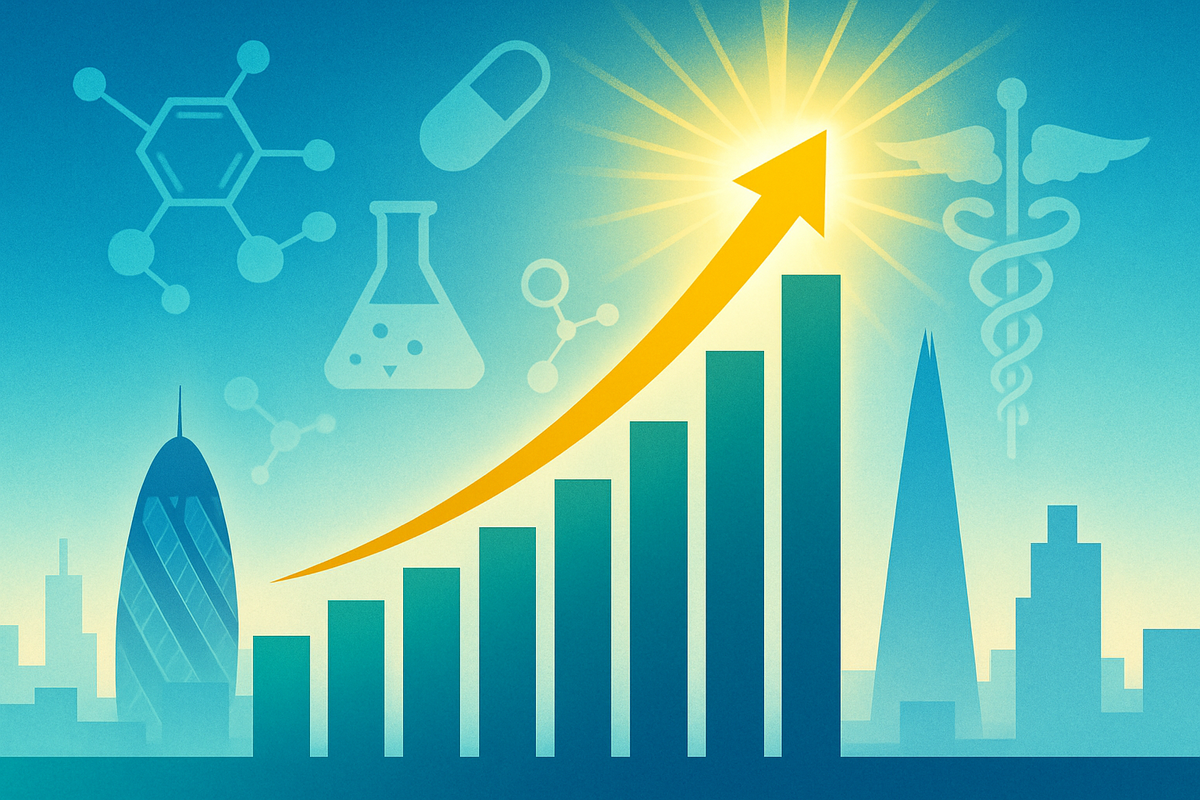
London's financial markets are buzzing today, October 1, 2025, as a robust rally in the pharmaceuticals sector has propelled the FTSE 100 to a new record high. This significant surge, primarily fueled by a landmark development in US drug pricing policy, underscores the critical influence of healthcare giants on the UK's leading stock index. The blue-chip index climbed to an intraday peak of around 9,457.91 points, closing at an unprecedented 9,446.43 points, marking a momentous occasion for investors and the broader market.
The pharmaceuticals sector's stellar performance today was ignited by a pivotal announcement concerning US drug pricing. The Trump administration reached an agreement with Pfizer (NYSE: PFE), where the pharmaceutical giant committed to implementing "most favored nation" pricing for the US Medicaid program. This means Pfizer will match the lowest prices offered in other wealthy nations. In exchange, Pfizer secured a three-year reprieve from potential US tariffs that had loomed over the pharmaceutical industry, easing significant concerns about protectionism and its impact on profitability. This development served as a powerful catalyst, sparking a broad-based rally across healthcare stocks, not only in the UK but also across Europe.
Pharma's Prowess: A Deeper Dive into the Day's Dynamics
The specific details of today's market action highlight the sheer strength of the pharmaceutical sector. UK-listed pharmaceutical behemoths experienced substantial increases in their share prices. AstraZeneca (LSE: AZN) was a standout performer, with its shares rallying by over 11% and reclaiming its position as the largest UK-listed company by market capitalization, surpassing banking heavyweight HSBC (LSE: HSBA). Other key players also posted impressive gains, with Hikma Pharmaceuticals (LSE: HIK) rising over 5% and GSK (LSE: GSK) gaining more than 6%. These significant movements collectively contributed to the FTSE 100's ascent to its record-breaking levels.
The timeline of events leading up to this moment saw growing investor anxiety over potential US drug pricing reforms and protectionist trade policies. The agreement between the Trump administration and Pfizer effectively mitigated these fears, providing much-needed clarity and stability for the sector. Analysts were quick to react, with JPMorgan viewing Pfizer's agreement as a potential "bellwether for the sector," anticipating similar manageable impacts on European pharmaceutical companies with significant US operations. This positive sentiment quickly translated into bullish trading activity, driving up valuations across the board. The immediate market reaction was overwhelmingly positive, demonstrating a collective sigh of relief and renewed confidence in the pharmaceutical industry's outlook.
Winners and Losers: Navigating the Market's Shifting Sands
The recent rally in the pharmaceuticals sector has created clear winners and, potentially, some indirect losers within the market. AstraZeneca (LSE: AZN) stands as a prime beneficiary, with its shares surging and solidifying its position as a market leader. This renewed investor confidence stems from its robust drug pipeline, strong global presence, and now, a clearer regulatory landscape in a key market like the US. Similarly, GSK (LSE: GSK) and Hikma Pharmaceuticals (LSE: HIK) have seen significant gains, reflecting their substantial exposure to the US market and the positive implications of the drug pricing agreement. These companies, with diversified portfolios and strong R&D capabilities, are well-positioned to capitalize on the reduced regulatory uncertainty and potentially more predictable revenue streams from the US.
Conversely, while no direct "losers" emerged from this specific pharmaceutical rally, companies in other sectors that are less directly impacted by global policy shifts might see their relative attractiveness diminish in the short term. For instance, while the FTSE 100 hit a record high, the outsized performance of pharmaceuticals could mean that sectors with less compelling news or facing their own headwinds might experience comparatively slower growth or even outflows as investors reallocate capital towards the surging healthcare sector. Companies heavily reliant on stable, predictable growth without the catalyst of a major policy shift might find themselves overshadowed by the pharmaceutical giants. However, the overall positive sentiment driven by the FTSE 100's record high could still provide a general uplift across various sectors, albeit to a lesser degree than the direct beneficiaries in pharma.
Wider Significance: A Bellwether for Broader Market Trends
The pharmaceutical rally and the FTSE 100's record high are not isolated events but rather indicative of broader industry trends and significant shifts in the global financial landscape. This event underscores the defensive appeal of healthcare stocks, which are often favored during periods of economic uncertainty due to their consistent demand regardless of economic cycles. The resolution of the US drug pricing dispute, even partially, signals a potential easing of regulatory pressures that have long weighed on the sector, possibly paving the way for more stable growth and investment. This could encourage further innovation and R&D spending within the pharmaceutical industry, benefiting patients and shareholders alike.
The ripple effects of this event extend beyond the pharmaceutical sector. The improved outlook for major pharma companies could positively impact their partners, including contract research organizations (CROs) and biotech firms that collaborate on drug development. Regulatory bodies will closely observe the implementation of the "most favored nation" pricing agreement, as it could set a precedent for future negotiations and influence healthcare policies globally. Historically, periods of regulatory clarity or favorable policy shifts have often led to significant rallies in the pharmaceutical sector, drawing parallels to past instances where major healthcare legislation or trade agreements spurred investor confidence. This current event, therefore, fits into a pattern of market response to perceived stability and growth opportunities within a crucial industry.
What Comes Next: Navigating the Future Landscape
In the short term, the momentum from the pharmaceutical rally is likely to continue, potentially drawing further investment into the sector. Investors will be closely watching for similar agreements between the US administration and other major pharmaceutical companies, which could further solidify the positive sentiment. The increased market capitalization of pharmaceutical giants could also lead to a re-evaluation of their weighting within major indices, potentially attracting even more passive investment. However, market participants will also be vigilant for any signs of renewed regulatory scrutiny or shifts in political rhetoric that could reintroduce uncertainty.
Looking further ahead, the long-term implications are significant. The "most favored nation" pricing model, if widely adopted, could fundamentally alter the revenue models for pharmaceutical companies with substantial US operations. This could necessitate strategic pivots, focusing on cost efficiencies, diversifying market exposure, and accelerating innovation to maintain profitability. New market opportunities may emerge for companies that can adapt quickly to these evolving pricing dynamics, potentially through novel drug delivery systems or personalized medicine approaches. Challenges will include managing profit margins under potentially lower drug prices and navigating complex global regulatory environments. Potential scenarios range from a sustained bull run in the pharmaceutical sector, driven by continued policy clarity and innovation, to periods of volatility if new regulatory hurdles emerge or if the global economic outlook deteriorates.
Comprehensive Wrap-up: Assessing the Lasting Impact
Today's rally in the pharmaceuticals sector, culminating in the FTSE 100 reaching a record high, marks a significant moment for the UK financial markets. The key takeaway is the profound impact of regulatory clarity and favorable policy developments on investor confidence, particularly in a sector as critical and heavily regulated as pharmaceuticals. The agreement on US drug pricing has not only de-risked a major aspect of the industry but has also underscored the defensive strengths and growth potential of healthcare companies.
Moving forward, the market will assess the sustainability of this rally. While the immediate catalyst is strong, investors should watch for the broader economic indicators, the trajectory of global inflation, and any further developments in international trade and healthcare policy. The performance of key pharmaceutical players like AstraZeneca, GSK, and Hikma Pharmaceuticals will be crucial barometers for the sector's health. For investors, this event highlights the importance of understanding sector-specific catalysts and their potential to drive overall market performance. The lasting impact could be a re-rating of the pharmaceutical sector, positioning it as a cornerstone of stability and growth within the FTSE 100 for the foreseeable future.
This content is intended for informational purposes only and is not financial advice





